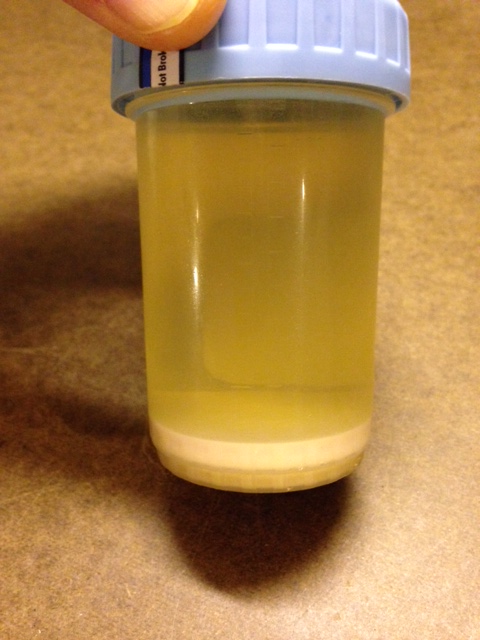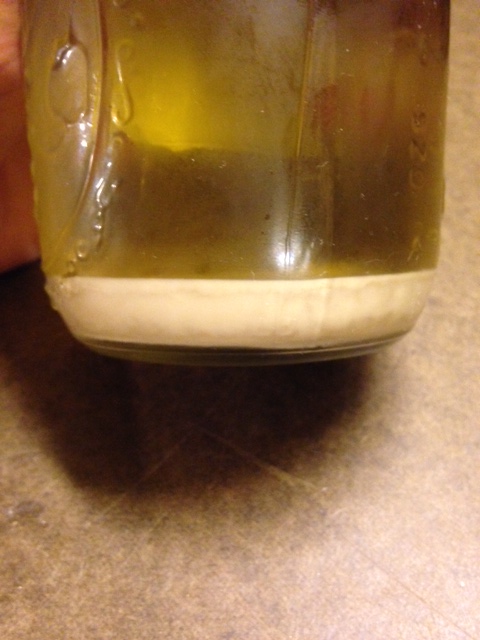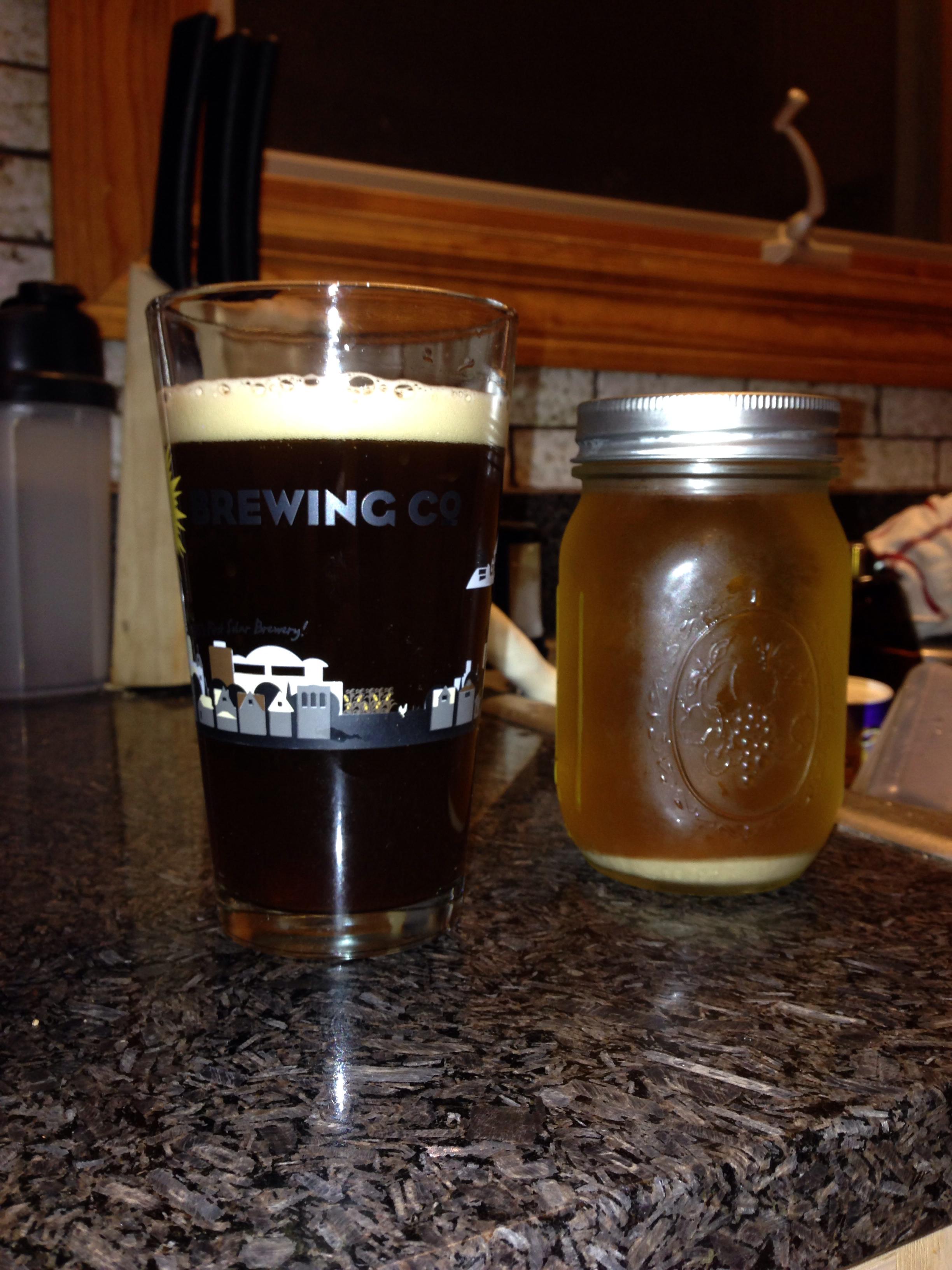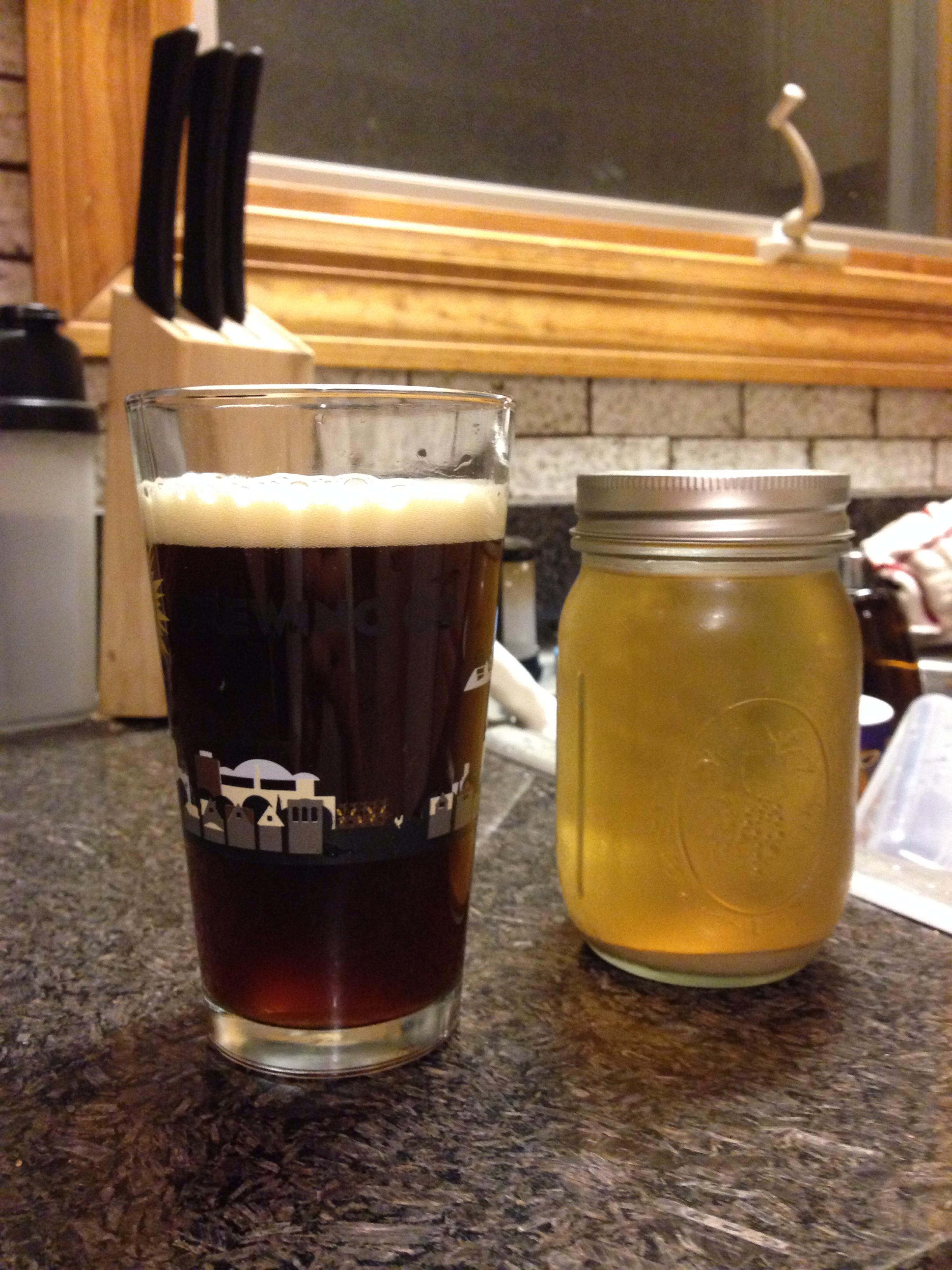Of course you're free to do that, but just be mindful that any additional transfer increases the infection risk. I'd say the risk is minimal with the usual precautions, but I wouldn't bother unless you need to save the space or really want the jars for something else.
You are using an out of date browser. It may not display this or other websites correctly.
You should upgrade or use an alternative browser.
You should upgrade or use an alternative browser.
Yeast Washing Illustrated
- Thread starter Bernie Brewer
- Start date

Help Support Homebrew Talk - Beer, Wine, Mead, & Cider Brewing Discussion Forum:
This site may earn a commission from merchant affiliate
links, including eBay, Amazon, and others.
Of course you're free to do that, but just be mindful that any additional transfer increases the infection risk. I'd say the risk is minimal with the usual precautions, but I wouldn't bother unless you need to save the space or really want the jars for something else.
I figured it would be much easier to measure the amount that way? I have done pint jars in the past, but that's a little harder to measure.
Yes it would be.
Here's a suggestion for a short-cut. It only requires one extra piece of equipment, but it saves a washing step. That extra piece of equipment is a "Sun tea jar with a spigot." You may already have one. Sanitize it before use, of course. Dump the sterile water from your quart jars into your carboy and slosh it around. Immediately pour the carboy's contents into the Sun Tea jar. Let it settle for 30 minutes. The yeast will stay in suspension while the trub will fall to the bottom. The longer you wait, the cleaner your yeast will be, though the yield will be slightly lower. Dispense the suspended yeast from the spigot into your sanitized jars, cap, and refrigerate. (The trick is that the spigot doesn't drain from the bottom of the jar, so the sediment isn't disturbed when you dispense the yeast).
cubbiebrewer
Member
- Joined
- Nov 17, 2013
- Messages
- 13
- Reaction score
- 0
So I followed this sticky as a first time yeast washer. Being the paranoid brewer I am, wanted to get peoples opinions on how my yeast looks. Brewed a porter and didn't have a hop sack so can't tell if area at the bottom is all trub or if that is the yeast. Any thoughts? Oh and it's been in the fridge for about 2 weeks now.




BrewCityBaller
Well-Known Member
So I followed this sticky as a first time yeast washer. Being the paranoid brewer I am, wanted to get peoples opinions on how my yeast looks. Brewed a porter and didn't have a hop sack so can't tell if area at the bottom is all trub or if that is the yeast. Any thoughts? Oh and it's been in the fridge for about 2 weeks now.
View attachment 160926
View attachment 160927
Did you rack all of the beer off the yeast cake before washing? And you added the clean water and swirled it around??
I just can't believe the liquid in there is that dark!! It really looks like the porter is sitting on top...
It does look a little bit like yeast on the bottom there, I am just so confused by the water. I washed the yeast from a black IPA a few weeks ago and the yeast is white at the bottom and the water slightly brown. I can take a picture when I get home if you are interested.
Edit: That is also a truly impressive amount of yeast, which is making me think it's not all yeast...
Can you outline the actual procedure you used to do this?
cubbiebrewer
Member
- Joined
- Nov 17, 2013
- Messages
- 13
- Reaction score
- 0
I racked as best I could, I can never get ALL the beer out of the fermenter, but certainly get as much as I can.
Yes, added the boiled (and cooled) water. Tried draining a little bit of the water off that once it settled for a while and then filled up a 1/2 gallon growler. Once that settled, poured the liquid off the top again and filled up this jar and a flip top bottle (only two "jars" I had at the time) and dumped the rest out of the growler. And here we are....I am contemplating going ahead and doing a starter even though I'm not planning on brewing for a little while longer just to see if what I have is actual yeast and then just harvesting what I grow in the starter.
Would love to see a photo of yours.
Yes, added the boiled (and cooled) water. Tried draining a little bit of the water off that once it settled for a while and then filled up a 1/2 gallon growler. Once that settled, poured the liquid off the top again and filled up this jar and a flip top bottle (only two "jars" I had at the time) and dumped the rest out of the growler. And here we are....I am contemplating going ahead and doing a starter even though I'm not planning on brewing for a little while longer just to see if what I have is actual yeast and then just harvesting what I grow in the starter.
Would love to see a photo of yours.
BrewCityBaller
Well-Known Member
I racked as best I could, I can never get ALL the beer out of the fermenter, but certainly get as much as I can.
Yes, added the boiled (and cooled) water. Tried draining a little bit of the water off that once it settled for a while and then filled up a 1/2 gallon growler. Once that settled, poured the liquid off the top again and filled up this jar and a flip top bottle (only two "jars" I had at the time) and dumped the rest out of the growler. And here we are....I am contemplating going ahead and doing a starter even though I'm not planning on brewing for a little while longer just to see if what I have is actual yeast and then just harvesting what I grow in the starter.
Would love to see a photo of yours.
Hmmm, I pretty much did the same thing:
-Racked beer into bottling bucket
-Added cleaned and cooled water and swirled it around
-Poured water off into large jar
-Let settle for ten minutes, then poured into smaller jar
The only difference I guess is that I am pretty anal about getting as much beer out of my fermenter and into the bucket as possible. I will take a picture of mine (next to a glass of the beer it came from) when I get home.
I would guess you are probably okay to make a starter. Just pour off as much as possible. It will probably be just fine.
For reference, this is Bell's yeast I rinsed, but it came from a Two Hearted clone, which is very light.

This I rinsed from a porter, but it was getting old, so I made a starter and saved that to grow up some more cells.

See the lighter stuff mixed in with the darker stuff? The lighter stuff is the yeast. This is how my rinsed yeast always looks.

This I rinsed from a porter, but it was getting old, so I made a starter and saved that to grow up some more cells.

See the lighter stuff mixed in with the darker stuff? The lighter stuff is the yeast. This is how my rinsed yeast always looks.
divrguy
Well-Known Member
- Joined
- Dec 19, 2011
- Messages
- 1,250
- Reaction score
- 99
I have a question for the guys who really know the details. Always wanted to try this so i picked up everything and its pretty easy. Using the small mason jars i end up with abut 1/2 in of yeast. I know i need a starter for a big batch but will 1 or 2 jars in a pinch do a 1 gallon pilot batch?
Use Mr Malty's calculator (repitching from slurry tab) to find out how much volume of yeast slurry you'd need based on the OG of your beer.
pumpkinman2012
Well-Known Member
- Joined
- Jan 7, 2013
- Messages
- 1,104
- Reaction score
- 148
Attempting my first yeast washing as we speak!
Thanks for the pictorial, it makes it a whole lot easier to understand.
Thanks!
Thanks for the pictorial, it makes it a whole lot easier to understand.
Thanks!
Brulosopher
Well-Known Member
- Joined
- Jun 1, 2011
- Messages
- 3,007
- Reaction score
- 447
pumpkinman2012 said:Attempting my first yeast washing as we speak! Thanks for the pictorial, it makes it a whole lot easier to understand. Thanks!
What's even easier is harvesting yeast from starters
BrewCityBaller
Well-Known Member
I racked as best I could, I can never get ALL the beer out of the fermenter, but certainly get as much as I can.
Yes, added the boiled (and cooled) water. Tried draining a little bit of the water off that once it settled for a while and then filled up a 1/2 gallon growler. Once that settled, poured the liquid off the top again and filled up this jar and a flip top bottle (only two "jars" I had at the time) and dumped the rest out of the growler. And here we are....I am contemplating going ahead and doing a starter even though I'm not planning on brewing for a little while longer just to see if what I have is actual yeast and then just harvesting what I grow in the starter.
Would love to see a photo of yours.
Yeast harvested from this Black IPA:


brewski09
Well-Known Member
cubbiebrewer said:So I followed this sticky as a first time yeast washer. Being the paranoid brewer I am, wanted to get peoples opinions on how my yeast looks. Brewed a porter and didn't have a hop sack so can't tell if area at the bottom is all trub or if that is the yeast. Any thoughts? Oh and it's been in the fridge for about 2 weeks now.
Your washing could have been "better" in pure terms, but this is very usable yeast with tons of viable cells. The downside to washing is you lose cells. Porters are neither high gravity nor highly hopped and if you diluted the beer with water, the acidity is bound to not be very low either. You do have some grub in there, but it won't affect a future beer's flavor profile. If you want it to look like some of the other examples you have been shown, pour off the dark beer/water and rinse again. You will lose more yeast this way, but it will look "like its supposed to." Some will tell you your washed yeast is unacceptable. I can tell you from experience it's viable and just fine as is. RDWHAHB

cubbiebrewer
Member
- Joined
- Nov 17, 2013
- Messages
- 13
- Reaction score
- 0
brewski09 said:Your washing could have been "better" in pure terms, but this is very usable yeast with tons of viable cells. The downside to washing is you lose cells. Porters are neither high gravity nor highly hopped and if you diluted the beer with water, the acidity is bound to not be very low either. You do have some grub in there, but it won't affect a future beer's flavor profile. If you want it to look like some of the other examples you have been shown, pour off the dark beer/water and rinse again. You will lose more yeast this way, but it will look "like its supposed to." Some will tell you your washed yeast is unacceptable. I can tell you from experience it's viable and just fine as is. RDWHAHB
Thanks brewski. Honestly, that's what I thought just figured I would ask. Funny how often home brewers need to tell themselves rdwhahb. Guess the main issue moving forward will be how much of a starter to make for the next beer seeing as how I don't have a true "measurable" quantity of viable yeast because I am sure not all of what I have in there is yeast. Certainly don't want to over/under pitch and just wonder if I would be better off making a start and washing it before making another starter to actually use on brew day??
ultravista
Well-Known Member
Who here harvests their yeast from starters vs. from washing post-fermentation?
Almost exclusively from starters now. It's so much easier and I feel you get cleaner yeast from it.
Brulosopher
Well-Known Member
- Joined
- Jun 1, 2011
- Messages
- 3,007
- Reaction score
- 447
ultravista said:Who here harvests their yeast from starters vs. from washing post-fermentation?
Uhhhh... starters exclusively
Malt-O-Mixer
Member
Here is a pic of the third attempt at washing my yeast. This batch is WL London Ale 013 from an imperial stout. After all the time spent doing this, which I don't really mind, I think I will try Brulosopher's method of using starters. I used a 3rd gen of a WL Dry English Ale WL 007 for a Blonde Ale currently bottle conditioning. Cheers everyone!



Brulosopher said:Uhhhh... starters exclusively
+1 on harvesting from a starter - easier, cleaner - dare I say better.
Just an FYI, supposedly you shouldn't wash the yeast from a high alcohol beer, which I'm assuming your imperial stout was. Now, I've never tried it, but I've heard it's not good, but I've also seen people say they have, so you'll probably be fine.Here is a pic of the third attempt at washing my yeast. This batch is WL London Ale 013 from an imperial stout.
One of us. One of us!After all the time spent doing this, which I don't really mind, I think I will try Brulosopher's method of using starters. I used a 3rd gen of a WL Dry English Ale WL 007 for a Blonde Ale currently bottle conditioning. Cheers everyone!
brewski09
Well-Known Member
mtnagel said:Just an FYI, supposedly you shouldn't wash the yeast from a high alcohol beer, which I'm assuming your imperial stout was. Now, I've never tried it, but I've heard it's not good, but I've also seen people say they have, so you'll probably be fine.
I hear this time and again. It has to do with stressing the yeast, but I find if you make a nice low gravity beer that it's just fine to reuse up to 20% ABV. I assume the OP isn't using yeast from an imperial stout that's that strong, so the yeast should be okay for a bit.
Thanks for the info.
ultravista
Well-Known Member
But there's so much yeast to dump down the drain of not saved after a ferment 
How much do you need, man?!?! You can get enough yeast for like 4 more batches and those 4 can make enough for 16 more, etc, etc.But there's so much yeast to dump down the drain of not saved after a ferment
Malt-O-Mixer
Member
I hear this time and again. It has to do with stressing the yeast, but I find if you make a nice low gravity beer that it's just fine to reuse up to 20% ABV. I assume the OP isn't using yeast from an imperial stout that's that strong, so the yeast should be okay for a bit.
The imperial stout I was referring to had an OG of 1.074. It was my 2nd all grain batch attempt. That doesn't sound too high as far as what mtnagel was suggesting, correct?
brewski09
Well-Known Member
The imperial stout I was referring to had an OG of 1.074. It was my 2nd all grain batch attempt. That doesn't sound too high as far as what mtnagel was suggesting, correct?
I've reused wlp001 California's ale yeast strain after making dogfish Head 90 minute IPA for a few generations. That's a resilient strain that will hit at least 12-14% ABV though. What strain were you using? It will probably be fine unless it's a strain known for only lasting a few generations before mutating.
ultravista
Well-Known Member
My WLP007 does not attenuate as well as it used to. 007 is a real clumper but after using it a few times, the clumping is very minor now.
Brulosopher
Well-Known Member
- Joined
- Jun 1, 2011
- Messages
- 3,007
- Reaction score
- 447
ultravista said:My WLP007 does not attenuate as well as it used to. 007 is a real clumper but after using it a few times, the clumping is very minor now.
Try harvesting 007 from starters, it'll perform almost exactly the same every time
Brulosopher
Well-Known Member
- Joined
- Jun 1, 2011
- Messages
- 3,007
- Reaction score
- 447
jessej122 said:How does this look and tips or suggestions?
If you accurately rinsed your yeast, the liquid in top would be almost clear. Harvesting from starters is easier and cleaner
Yeah, the dark stuff under the off-white stuff isn't yeast, it is break material/trub. The palest stuff is the yeast, so you can tell there is not as much yeast as other stuff. That is ok, but it could have been rinsed better, and left a higher ratio of yeast to trub. You need to let it settle longer, and pour more carefully, to get more yeast and less trub.
brewski09
Well-Known Member
jessej122 said:Will it still be viable to make a starter with?
Yes. Definitely. I would caution against leaving it too long as the darkness indicates substantial highly kilned malts which cause a drop in pH. In other words, it's a stressful environment for the yeast.
bwalcottayers
Member
- Joined
- Jun 13, 2013
- Messages
- 7
- Reaction score
- 2
divrguy said:I have a question for the guys who really know the details. Always wanted to try this so i picked up everything and its pretty easy. Using the small mason jars i end up with abut 1/2 in of yeast. I know i need a starter for a big batch but will 1 or 2 jars in a pinch do a 1 gallon pilot batch?
How many of the jars did you end up with? On average I'll get 4 jars filled and each contain roughly 200B cells. 200B is just under a normal pack or vial you'd buy.
tgmartin000
Well-Known Member
Here's another "how does this look" question. I think I added too little water. I think the darker brown layer on top is my Conan, is this correct? Should I just dump the wash water and yeast layer into a new starter? It's been in my fridge for 2 weeks, but even small disturbances cause the yeast to re-suspend.


brewski09
Well-Known Member
tgmartin000 said:Here's another "how does this look" question. I think I added too little water. I think the darker brown layer on top is my Conan, is this correct? Should I just dump the wash water and yeast layer into a new starter? It's been in my fridge for 2 weeks, but even small disturbances cause the yeast to re-suspend.
If it re-suspends that easily I would just add it all. Pretty much looks like it's all usable to me.
tgmartin000
Well-Known Member
If it re-suspends that easily I would just add it all. Pretty much looks like it's all usable to me.
Awesome. Thanks brewski.
Similar threads
- Replies
- 2
- Views
- 402
- Replies
- 4
- Views
- 396
- Replies
- 3
- Views
- 731
- Replies
- 81
- Views
- 4K


